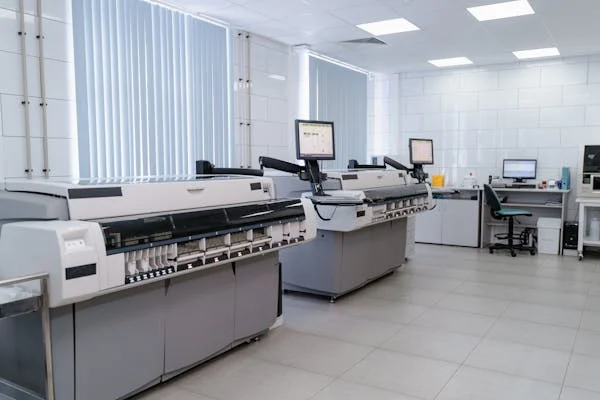Corporate innovation is no longer a choice—it’s a necessity. In today’s fast-moving world, businesses that don’t innovate fall behind. While every company aims to be more innovative, some industries are consistently ahead of the curve. This stat report explores the top 30 industries leading in innovation today. Each section dives into a key stat and explains how and why these industries stand out—and what your business can learn from them.
1. 70% of global R&D investment comes from just five industries: pharmaceuticals, automotive, software & internet, technology hardware, and industrials
These five industries dominate the R&D landscape. When 70% of the world’s innovation spending comes from them, it’s clear they’re setting the pace.
Why are they ahead?
It starts with how they think about problems. These sectors don’t just improve existing products—they build entirely new ones. Pharma discovers life-saving drugs. Tech companies develop platforms we never imagined a decade ago. Automotive firms create self-driving cars. They’re not fixing—they’re inventing.
They also understand that innovation is expensive but necessary. By allocating large budgets to research, they gain a competitive edge that’s hard to beat.
What you can learn
You don’t have to match their budgets. But you should think like they do. Here’s how:
- Dedicate time weekly to idea development.
- Give your team freedom to test small ideas.
- Set clear metrics to track which ideas are worth pursuing.
Innovative thinking isn’t limited to R&D departments. Make it part of your company culture.
2. The technology sector leads in R&D intensity, spending over 10% of revenue on average
Tech companies like Google, Microsoft, and Apple pour more than 10% of their revenue into innovation. This intense focus helps them stay ahead.
Why R&D intensity matters
Spending a higher percentage of revenue means these companies take innovation seriously. They don’t see R&D as an optional expense but as a core investment in their future. That’s why they continue to dominate market share and customer loyalty.
How you can apply this
Even with a smaller budget, you can:
- Allocate a fixed percentage of your budget to testing new ideas.
- Track the ROI of past innovations to justify further investment.
- Involve different departments in innovation projects.
This consistent focus on experimentation keeps your business agile and future-ready.
3. Pharmaceutical companies allocate approximately 20% of revenue to R&D—the highest of any sector
Pharma companies, like Pfizer and Novartis, are innovation machines. Their entire model depends on finding new drugs before patents expire.
The high cost of progress
Drug development takes time—up to 15 years—and the risk of failure is high. Yet, these companies invest anyway. Why? Because one breakthrough drug can generate billions in revenue.
Takeaways for other industries
Here’s what you can take from pharma’s approach:
- Be willing to play the long game.
- Accept that not every idea will work—but one might change everything.
- Track trends and consumer shifts early, and start developing responses before competitors do.
By learning from pharma, you build a mindset where calculated risks are normal.
4. Automotive industry R&D investment hit $150 billion in 2023 globally
The automotive world is transforming faster than ever—from electric vehicles (EVs) to autonomous driving.
Why such massive investment?
Cars aren’t just transport anymore. They’re rolling computers. Companies like Tesla, Toyota, and BMW are pushing tech boundaries. Safety, fuel efficiency, and user experience are all being reimagined.
How you can match the mindset
Even if you’re in a completely different industry, this should inspire you:
- Don’t wait for your product to become outdated—rethink it now.
- Study what adjacent industries are doing to innovate.
- Look at what customers want next, not just what they want now.
Innovation means staying a step ahead, not following the trend.
5. The software & internet sector accounts for over 25% of all venture capital-backed innovation
Startups in this space attract the most VC funding because of their scalability and speed.
Why VCs love this sector
Software solves problems quickly and can scale globally without physical infrastructure. It’s lean, fast, and often repeatable. Investors love that.
What to do with this insight
Even if you’re not building software, adopt its agile principles:
- Build fast and test fast.
- Make user feedback central to your product development.
- Launch version 1.0 and improve from there, instead of chasing perfection.
Speed is your best friend in the innovation race.
6. 90% of the top 50 most innovative companies belong to technology, automotive, and pharmaceutical sectors
These three industries dominate the innovation landscape. The reason is simple—they never stop pushing boundaries.
What makes them different?
It’s not just about money. They encourage internal idea sharing, fund experimental projects, and are constantly learning. They also have leaders who understand the power of innovation.
How to follow their lead
Ask yourself:
- Do you reward innovation in your team?
- Do you allow time for creative thinking?
- Do you celebrate small wins as much as big ones?
Build a structure that supports and rewards innovation—and your team will rise to the occasion.
7. Aerospace and defense companies invest an average of 5% of revenues into R&D
This may seem low compared to pharma, but the innovation in aerospace is next-level. Think reusable rockets and autonomous drones.
Why innovation matters here
Safety and precision are non-negotiable. These companies focus on engineering breakthroughs that change entire industries—like space travel.
Lessons to apply
Think about precision in your own industry:
- Are your systems reliable and scalable?
- Can you innovate in ways that reduce failure or error rates?
- What’s your equivalent of a moonshot project?
Even small companies can aim high with the right mindset.
8. Financial services firms increased innovation spend by 15% in 2023, driven by fintech competition
The financial world is undergoing a quiet revolution. Traditional banks and insurance firms are investing more in digital innovation—thanks to fintech startups that are rethinking everything from payments to lending.
What’s causing the push?
Fintech firms like Stripe, Revolut, and Chime have shown that consumers crave fast, easy, digital-first financial services. That’s pressured legacy institutions to catch up. From AI chatbots to blockchain applications, innovation has become a must.
How you can keep up
If you’re in a mature industry like finance, the lesson is clear:
- Don’t ignore startups—study what they’re doing better.
- Prioritize user experience. Your interface is often the entire customer journey.
- Partner with or acquire smaller, innovative companies instead of competing with them head-on.
Stay close to what customers want, and you won’t fall behind.
9. Semiconductor firms invest roughly 16% of revenue in R&D annually
Semiconductors power the world—from your phone to satellites. Companies like Intel, TSMC, and NVIDIA keep pushing what’s possible.
Why the focus on R&D?
Miniaturization, speed, and energy efficiency drive the chip race. One breakthrough can lead to a 10x improvement. That’s why these firms put so much into R&D.
What to learn from their focus
Even if your business isn’t technical:
- Focus on improving the core of what makes your product valuable.
- Make performance a priority—whatever that looks like in your field.
- Allocate budget to revisit and rethink your core offering, not just the extras.
Sometimes, refining what you already do can yield the biggest returns.
10. 60% of top-performing consumer goods companies attribute growth to innovation in product development
Whether it’s sustainable packaging or plant-based food, innovation in consumer goods is booming.
Why this stat matters
Consumers today are picky and aware. They want products that align with their values and tastes. The brands that listen—and adapt—win.
What you can do
Consumer-facing companies must stay curious:
- Use customer feedback loops religiously.
- Experiment with limited edition releases to test interest.
- Track cultural shifts that could create new product niches.
The world is changing fast. Your product should too.
11. The energy sector’s clean tech investment surged to over $130 billion in 2023
Energy is moving from fossil fuels to renewables. Fast. Solar, wind, hydrogen, and battery storage are all seeing record investments.
What’s powering the shift?
Regulatory changes, public demand for sustainability, and cost drops in clean tech. Energy giants now see innovation as their future—not just a buzzword.
What this means for you
If you’re in a legacy industry, this shift shows:
- Even old-school sectors must reinvent themselves.
- Regulatory trends can create innovation opportunities.
- Consumers reward sustainability—make it a central value, not a side note.
Get ahead by embracing change instead of resisting it.
12. Healthcare saw a 40% increase in AI-based innovation initiatives between 2021 and 2023
From diagnosis tools to robotic surgery, AI is transforming healthcare. It’s not just hype—it’s improving outcomes and reducing costs.
Why AI works here
AI can process huge amounts of data—faster and more accurately than humans. That’s perfect for healthcare, where data is everywhere and decisions are critical.

What to take away
Whether you’re in healthcare or not:
- Use AI to automate repetitive tasks.
- Invest in data literacy across your team.
- Partner with tech providers to experiment with AI applications.
This isn’t just about efficiency—it’s about freeing your team to do deeper, more valuable work.
13. Retail and e-commerce sectors grew digital innovation budgets by 22% in 2023
Shopping is no longer just in stores. It’s happening on phones, through social media, and via voice commands. Retailers are racing to keep up.
What’s driving the surge?
Customer expectations. They want personalization, speed, and convenience. Retailers are investing in AI, AR, chatbots, and data analytics to deliver.
What you can do
Even if you’re not in retail:
- Study how people engage with your brand across platforms.
- Make digital experiences seamless and personal.
- Experiment with new channels—like social commerce or live streaming.
Digital is where the attention is. Meet customers where they are.
14. 65% of industrial manufacturing companies report innovation as a top strategic priority
The manufacturing world isn’t what it used to be. Robotics, digital twins, and smart factories are changing the game.
Why the shift?
Global competition and labor shortages are pushing manufacturers to modernize. Innovation helps them boost efficiency and cut costs.
What you can learn
Even if you’re not making physical products:
- Look for ways to automate manual processes.
- Invest in systems that reduce waste and boost quality.
- Collaborate with universities or startups to pilot new tech.
Innovation isn’t just about what you make—it’s also about how you make it.
15. The telecom sector ranks in the top 5 industries for patent filing volume globally
Telecom firms are behind the networks we all use—but they’re also quietly driving innovation in hardware, spectrum, and services.
Why so many patents?
5G, IoT, and satellite internet are reshaping how we connect. Companies like Qualcomm and Ericsson are competing on innovation, not just coverage.
What you can apply
If your business involves communication in any form:
- Stay on top of connectivity trends.
- Look for ways to improve speed and reliability in your offerings.
- Secure intellectual property for your key ideas—it adds value and defensibility.
Protecting your ideas is as important as creating them.
16. Biotech startups account for over 35% of new drug approvals in the last 5 years
Big pharma isn’t the only player in drug discovery. Small, nimble biotech firms are leading the charge.
Why startups are thriving
They’re more focused, take bigger risks, and often spin out from academic labs with cutting-edge ideas. Their size makes them agile.
How to take advantage
In any industry:
- Build small teams with freedom to experiment.
- Don’t be afraid to work on moonshot ideas.
- Explore partnerships between large firms and smaller innovators.
Agility + bold ideas = innovation power.
17. Cloud services and infrastructure firms doubled their innovation spending from 2020 to 2023
Cloud isn’t just a buzzword anymore—it’s the backbone of how modern companies operate. From data storage to AI tools, cloud infrastructure is where innovation lives.
Why the surge in investment?
The pandemic accelerated digital adoption. Businesses needed flexibility, remote access, and scalable solutions fast. This created a boom in demand, prompting companies like AWS, Azure, and Google Cloud to double down on new tools, integrations, and infrastructure.

What it means for your business
Whether you’re using cloud or considering it:
- Look into shifting legacy systems to cloud-based platforms.
- Use cloud-native tools to reduce infrastructure costs and improve agility.
- Encourage departments to explore software-as-a-service solutions that solve real problems.
The cloud is no longer optional. It’s a launchpad for innovation that can streamline almost any business.
18. Logistics and supply chain tech saw a 45% year-on-year increase in innovation funding in 2023
Supply chains used to be in the background. Now, they’re front and center. Disruptions from global events revealed how critical—and fragile—they are.
Why logistics is booming
Companies are investing in predictive analytics, smart warehousing, and last-mile delivery tech. The goal is to make supply chains faster, cheaper, and more resilient.
How to apply this thinking
Regardless of your industry:
- Analyze where delays or inefficiencies occur in your delivery process.
- Consider automation tools to track inventory or shipments in real time.
- Build relationships with tech partners that focus on supply chain improvements.
Fixing your back-end systems isn’t flashy—but it’s powerful.
19. EdTech innovation funding surpassed $20 billion globally in 2023
Education has been reinvented. Virtual classrooms, AI tutors, and gamified learning have turned EdTech into a powerhouse industry.
What’s driving the growth?
A global need for flexible, accessible learning. Students, professionals, and even corporations are demanding personalized, engaging platforms that deliver results.
What you can do with this insight
If you offer training, onboarding, or education of any kind:
- Explore digital learning tools to enhance engagement.
- Use microlearning formats to improve knowledge retention.
- Personalize content using adaptive learning techniques.
Education isn’t just for schools. Every business teaches something—and there’s huge room for improvement.
20. The agriculture and food tech industry saw a 30% growth in patented innovation since 2020
Agriculture might sound old-school—but it’s bursting with modern ideas. Drones, precision farming, vertical growing, and lab-grown meat are reshaping the food system.
Why the burst in patents?
Rising demand for sustainable food, coupled with climate change and population growth, has made innovation in this sector urgent. From farm to fork, every step is evolving.
What this means for you
If you’re in food, retail, sustainability—or just curious:
- Look for emerging technologies that reduce environmental impact.
- Support suppliers that innovate in production or packaging.
- Stay informed about food tech trends to adapt early.
Sustainability is more than a goal—it’s a growth strategy.
21. Gaming and digital entertainment sectors invest up to 8% of revenue in new product innovation
Gaming isn’t just fun—it’s serious business. With billions of players worldwide, this industry keeps evolving through immersive design, AI, and community-building.
Why this sector thrives
Games capture attention for hours. Studios constantly look for ways to improve engagement, storylines, and monetization models. Innovation is baked into every release.

What you can learn
Even if your industry is unrelated:
- Focus on user engagement—how do you keep customers coming back?
- Build communities around your product or service.
- Use feedback loops to refine your offerings quickly and consistently.
Entertainment teaches us that engagement is everything.
22. The construction tech industry grew 200% in innovation investment between 2019 and 2023
Construction has long been slow to change. But that’s shifting fast. Robotics, 3D printing, and project management software are now common.
Why this matters now
Labor shortages, safety concerns, and rising costs are forcing builders to rethink how they operate. Companies that innovate are completing projects faster and with fewer errors.
How to use this insight
Even if you’re not laying bricks:
- Evaluate manual processes in your business—can they be digitized or automated?
- Invest in tools that improve communication and transparency across teams.
- Use data from past projects to improve future performance.
Innovation often starts by improving what already exists.
23. 75% of insurance firms are actively pursuing digital innovation in claims and underwriting
The insurance world is transforming. Automation, AI, and big data are making the customer experience smoother and more reliable.
What’s changing?
Traditional paperwork is being replaced by instant digital assessments. Claims that took days now take minutes. This efficiency improves both margins and satisfaction.
What to apply in your business
Take a look at your most repetitive processes:
- Can any of them be automated?
- Are you using data to predict and solve customer needs?
- Do you offer digital self-service options?
Remove friction and you’ll win more loyal customers.
24. Electric vehicle companies account for nearly 50% of innovation in automotive
Electric vehicles (EVs) are more than just eco-friendly—they’re pushing the limits of design, software, and performance.
Why EV companies lead
Startups like Tesla, Rivian, and Lucid are tech companies at heart. They approach cars like software—with regular updates, AI-based systems, and customer-centric features.

How to think like an EV firm
You don’t need to build a car. But you can:
- Approach your product as a living system that can improve post-purchase.
- Build seamless customer experiences—from onboarding to updates.
- Use sustainability not just as a value, but as a feature.
Treat innovation as an ongoing journey, not a one-time event.
25. Smart home and IoT device companies filed over 20,000 patents in 2023
From thermostats to security systems, smart devices are everywhere. This surge in patents shows just how fast this space is growing.
Why IoT is exploding
Consumers want convenience, control, and safety. These companies deliver that through sensors, connectivity, and apps—all working in sync.
What you can do
If you make or sell physical products:
- Consider how they could integrate with a digital experience.
- Explore ways to make your product smarter or more intuitive.
- Think about how you can make everyday tasks easier for your users.
Smart isn’t just about tech—it’s about making life simpler.
26. AI and machine learning patents rose 34% year-over-year across all sectors in 2023
AI is touching everything. From marketing to healthcare to logistics, it’s helping companies work smarter.
Why the surge?
The tools are better, cheaper, and easier to integrate. Businesses are realizing that AI isn’t just hype—it’s practical and powerful.
What to do now
Even if you’re just starting out:
- Identify one repetitive task you could automate with AI.
- Start small—use off-the-shelf tools to test before building anything custom.
- Upskill your team so they understand the possibilities.
The AI future is here. Don’t be late.
27. Fintech companies account for 60% of innovation-related M&A activity in financial services
Mergers and acquisitions are exploding in fintech. Bigger firms are snapping up smaller, more innovative ones to stay relevant.
Why it’s happening
Fintechs move fast. They build better experiences and understand younger audiences. Larger companies see M&A as a shortcut to innovation.

How to use this model
Think beyond building everything in-house:
- Partner with smaller firms or startups.
- Consider strategic acquisitions to grow faster.
- Build ecosystems rather than isolated products.
You don’t have to invent everything. Just be smart about how you evolve.
28. Clean energy startups raised over $60 billion in innovation capital in 2023
The clean energy sector is booming. Startups are attracting big funding to develop wind, solar, hydrogen, and battery tech.
Why investors are excited
Climate change is a global challenge—and a massive business opportunity. Clean energy offers both impact and returns.
What you can do
Whether you’re a startup or established business:
- Embed sustainability into your innovation goals.
- Monitor clean energy trends—some may affect your operations or customers.
- Align your values with global sustainability goals—it attracts partners and talent.
Doing good can also be great business.
29. The media and advertising industry increased martech innovation spending by 18% in 2023
Marketing is becoming more science than art. Tools powered by AI, big data, and real-time analytics are driving this change.
Why martech is essential
Brands want to personalize everything. Martech makes it possible at scale—from automated email flows to predictive content engines.
How to adapt
If you communicate with customers:
- Audit your current tech stack. Is it helping or hindering?
- Invest in tools that give you data-driven insights.
- Make personalization a priority—not just a bonus.
The right tech makes your message hit harder.
30. Robotics and automation led innovation growth in manufacturing with 37% CAGR from 2020–2023
Robots are no longer just on car assembly lines. They’re in warehouses, surgeries, and even restaurants.
Why robots are everywhere
Labor shortages and cost pressures are driving demand. Robots offer consistent performance, reduced errors, and scalability.

What this means for your business
Automation doesn’t mean job loss—it means better use of human time:
- Automate low-value, repetitive tasks first.
- Use the time saved to invest in training and innovation.
- Think long-term about how automation can make your business more resilient.
The future isn’t just robotic—it’s smarter.
Conclusion
Innovation is the heartbeat of progress. These 30 stats show where it’s happening—and how. No matter your industry, there’s inspiration here for how to think bigger, move faster, and build better. Innovation isn’t reserved for tech giants. It’s a mindset, a method, and a muscle every business can develop.





















